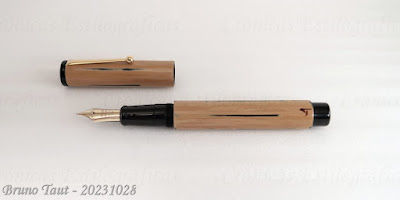 (This event was celebrated in a shop, and unfortunately the management did not authorized pictures. However, this being Japan, too often these decisions are enforced or not depending on the staff in charge. Fellow Fountain Pen Network subscriber Moskva (http://dondellinger.com/mipiace/index.php?) was allowed to take some pictures and I thank him for his permission to include them in this post. They are also published in this entry of the above-linked blog: http://dondellinger.com/mipiace/index.php?post/2010/05/18/Exposition-Maki-e-chez-Ito-ya).
(This event was celebrated in a shop, and unfortunately the management did not authorized pictures. However, this being Japan, too often these decisions are enforced or not depending on the staff in charge. Fellow Fountain Pen Network subscriber Moskva (http://dondellinger.com/mipiace/index.php?) was allowed to take some pictures and I thank him for his permission to include them in this post. They are also published in this entry of the above-linked blog: http://dondellinger.com/mipiace/index.php?post/2010/05/18/Exposition-Maki-e-chez-Ito-ya). These days –from May 12 to 24— stationery Itoya in Ginza (shop no. 15 in this link) in Tokyo organized what they called a Maki-e Fair. Five were the exhibitors invited to it: The three leading Japanese companies –Pilot-Namiki, Platinum-Nakaya, and Sailor—, the California-based Danitrio, and a fifth one dealing with Aurora, Caran d’Ache, Parker, Pelikan, and Waterman. All those brands showed their creations in maki-e and urushi (lacquer).
Pilot introduced a 10-unit limited edition of a black urushi finished exclusively for the Fair for JPY 52500. It only came with M nib. The whole line of maki-e by Pilot and all the Namiki branded pens were on display.
 The lower pen is urushi finished; the upper one, the regular black pen with golden accents. The difference, JPN 36750, and the nibs are exactly the same. Picture taken at the May meeting of the Wagner association (May 23, 2010).
The lower pen is urushi finished; the upper one, the regular black pen with golden accents. The difference, JPN 36750, and the nibs are exactly the same. Picture taken at the May meeting of the Wagner association (May 23, 2010).Platinum presented their first maki-e pen after a long time (I cannot find how long…), but their main selling point were those marketed under the Nakaya brand. However, the Nakaya craftsmen only attended the event on the last four days.
Sailor showed their urushi King of Pen line.
Finally, the Western companies showed their very limited set of products. Among them, two M1000-based Pelikan limited editions –Maiko in Kyoto and Fireworks—, and the Sérenité based Waterman models were the more interesting products.
There was also a maki-e workshop for those interested in learning the basics of the technique. It costed JPY 2100 and was quickly sold out.
Certainly, I am not enticed by these pens, Actually, I wonder if they really were pens ready to write. For sure, some of them were, as I had the chance to test some of the pieces. However, the writing experience was not in accordance with the price tag. And that is what finally counts.
Bruno Taut
(Shibuya, May 22, 2010)
[labels: Tokyo, Pilot, Sailor, Platinum, Danitrio, evento, FPN]






























































